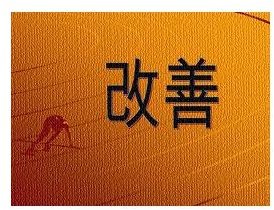Tips for Tracking the Results of Kaizen: Making Sure Your Improvement Process Works
Kaizen is Japanese for “improvement” or “change for the better.” In management science, it refers to a philosophy of focusing on continuous or relentless improvements at all levels of business activities to humanize the workplace, make work simple by eliminating overly hard work, and adopt a scientific method in work processes. Kaizen intervention usually improves process efficiency by reducing waste, improving productivity and enhancing quality.
The application of Kaizen takes many forms, such as individual suggestion schemes, empowered work groups, and more. One effective Kaizen methodology is making changes and monitoring results, then adjusting. The approach seeks to bring about change by making small experiments, and adapting whatever succeeds on a wider scale. Regardless of the measure adopted, a key component is a tracking measure that allows tracking the change, and whether the change meets the desired ends.
Establish a Paper Trail
Maintaining a paper or records trail is the easiest way to track the success of Kaizen initiatives. For instance, a Kaizen intervention may result in some change to the assembly line layout, which may speed up processing by a few minutes. However, without someone actually recording how much time the process took before the intervention and after the intervention, there is no way to ensure that the interventions have borne fruit.
Sometimes, intervention may yield some unintended benefits, which raises the importance of tracking even more. For instance, an intervention intended to cut input costs may fail in the desired objectives with input costs remaining constant, but the same intervention may have speeded the process to manufacture more units, increasing asset utilization and overall profits.
The easiest way to document kaizen is by developing a Kaizen event profile to identify the objective, team, timings and process information, followed by a simple Kaizen form for each initiative. The forms may include space for standard observations, set up observations, and tracking time, to measure changes at each state. Such forms allow for covering all bases, and lend a structure to the approach. Ensure that all Kaizen interventions take place only with such a form.
Rely on Analytics
Tracking progress through graphs, charts, maps and bar codes to track process time and statistical methods may be part of the normal managerial practice, or some other quality management tool. The same applications may find use to measure Kaizen results, comparing progress before and after the Kaizen interventions.
One good practice is to draw up a “current state” and “future state” process map for each Kaizen event. Highlight how individual roles fit into both current and future states, thereby mapping individual responsibilities. Comparison of the future state map with current state map after Kaizen implementation will show the extent of progress achieved. Develop a spreadsheet with listed tasks, or place a scheduling board at the workplace to track progress in reducing the gap.
Perform Periodic Audits

Periodic audits or self-assessments highlight the state of the systems and procedures that have undergone a Kaizen comparison of one audit with the previous one highlighting specific improvements or changes. Audits may be part of the organizational routine, or developed specifically to track Kaizen events. In either case, effectiveness depends on incorporating the required parameters, be it financial, time, person-hours or anything else in the audit scope.
If the Kaizen intervention is a corrective action plan that lists out specific points of improvement, the audit or review should incorporate the same parameters in a standard format, codified into quantifiable or measurable terms, and scrutinize the state of such parameters over time. A periodic audit report may read:
- Eliminate rework and duplication: 75 percent achieved.
- Reduce status update time: First cycle of training people on the new process and tools completed. Total progress 50 percent.
- Make current data readily available to all stakeholders: Fully implemented.
The format of such audits may take the shape of summary reports, spreadsheets or bulletins, made available to all stakeholders.
Such an approach not only allows tracking progress, but also results in a more transparent set-up and provides managers with easier access to relevant data.
A related method is examining periodic financial statements such the balance sheet, monthly cash flows statements and other records to determine improvement in finances or profitability. These approaches, however, do not make a direct association between the Kaizen event and changes in finances, leaving much to assumptions.
Surveys and Opinion Polls
Another tool to document and track Kaizen results is to conduct surveys and opinion polls. The advantage of surveys over audits or inspecting records is the possibility of tracking exactly what is required, and making direct associations. It is possible to customize surveys to track how specific interventions have changed specific processes or events, and administer the same to people directly involved in the intervention.
Surveys and opinion polls may take the same format of the audit, with the major difference being an increased reliance on employee and stakeholder opinions rather than passive fact-finding based on records and observations.
A Follow up Process
A follow-up event is essential to sustain the Kaizen intervention. Such follow-up could take the shape of a meeting of the stakeholders to review the intervention after a fixed period, say 30 days, entrusting a person to monitor the changed processes on a continuous basis until the changes freeze, and more. A continued follow-up by the facilitator or any other person entrusted with the task helps to maintain focus and freeze the changes.
The successful implementation of Kaizen depends on imbibing this philosophy in the routine work processes rather than considering it as a distinct activity. The involvement of all workers from the CEO down to the janitorial staff, and support from all stakeholders, both internal and external are needed in order for any Kaizen event to be tracked properly.
References
- “Kaizen Event Case Study.” http://www.epa.gov/lean/government/epa-initiatives/ocfo-casestudy.htm. retrieved August 21, 2011.
- Image Credit: Highway - flickr.com/Wouter Kiel under CC 2.0 license
- “A Paper Trail Leads to Success.” http://www.hartinnovations.com/LMA0203.pdf. Retrieved August 21, 2011.
- “It’s not easy to sustain those kaizen results.” http://www.reliableplant.com/Read/10114/kaizen-results. Retrived August 21, 2011.
- Image Credit: Kaizen- flickr.com/al del barrio under CC 2.0 license
